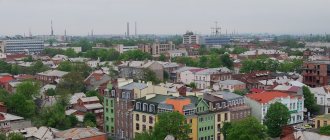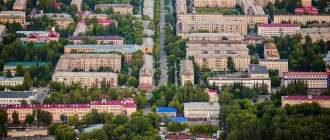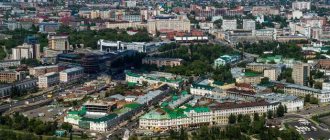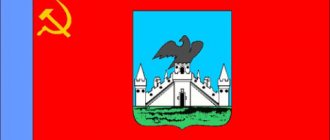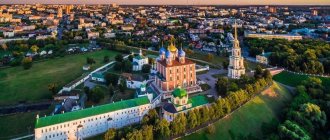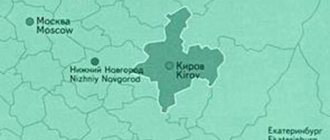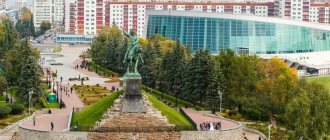Yaroslavl is the center of the Yaroslavl region, with a thousand-year history, which has become the cultural center of the Russian Federation. It is impossible to establish for certain how old the settlement is. It is known that it was founded around the 10th-11th centuries. Yaroslavl is one of the centers of domestic tourism. A beautiful city with a huge number of attractions attracts many guests. It is famous mainly for its architecture and rich industry. On its territory there are motor, electric locomotive repair, carriage repair, and shipbuilding plants. It is a developed transport hub - there are roads, railway lines, and an airport.
Official symbols approved by the city administration - coat of arms, flag. A bear is depicted holding a golden ax.
National composition
To obtain a complete demographic picture, it is necessary to determine the number of permanent residents and ethnic composition. According to the 2010 All-Russian Population Census, a significant part of the inhabitants of the city of Yaroslavl are Russians (95.1%). The second position is occupied by Ukrainians – 0.96 percent of the total. The third position is those surveyed who did not indicate their nationality – 0.87%.
0.4% is occupied by Armenians, Tatars, and Azerbaijanis. Belarusians – 0.3 percent. The following nations: Yazidis (0.3%), Roma (0.2%).
The next ones are Georgians (0.09%), Germans (0.08%). 0.07 percent are occupied by Jews, Chuvashs, and Chechens. The following ethnic groups are Moldovans, Tajiks, Mordovians, Uzbeks, Ingush, Legzgins, Bashkirs, Poles, Komi. Koreans and Udmurts close the list. Their share is 0.02%.
Great people of Yaroslavl
Speaking about the residents of Yaroslavl, one cannot help but recall the famous people thanks to whom this city has earned national fame. Among them are the famous naval commanders G. A. Spiridonov and F. F. Ushakov, the prominent Russian poet N. A. Nekrasov, opera singer L. V. Sobinov, the founder of the theater in Russia F. G. Volkov, designer V.I. Kalashnikov, inventor I.K. Sailors, the luminary of scientific pedagogy K.D. Ushinsky, Bolshoi Theater soloist A. O. Bantyshev, first female cosmonaut V. V. Tereshkova.
The monarchist sculptor A. M. Opekushin, the outstanding chemist D. I. Mendeleev, the famous landscape artist A. K. Savrasov, and professor of painting P. D. Buchkin worked in Yaroslavl.
Thus, various factors influence the demographic situation and population of the city. Yaroslavl is diverse and unique, and its natives can certainly be proud that they live in such a beautiful place with a long history.
Story
The city of Yaroslavl boasts a rich history. It is the oldest settlement on the Volga. According to historical documents, it was founded by Yaroslav the Wise, Prince of Rostov. The exact date of the founding of the village is unknown; historians claim that the event occurred around 1010 AD. The Yaroslavl Kremlin was founded on a well-protected territory. This territory subsequently received the status of its historical center.
The settlement played an important role in the internal politics of Rus' and the spread of Christianity in the North-Eastern part. Having the right location, the city of Yaroslavl in the 12th century turned out to be one of the centers of trade and crafts. Largest trading partners: Pskov, Novgorod. In addition, Yaroslavl merchants did business with the countries of the East and West. There are references to the settlement in Scandinavian folklore.
In 1238 it was destroyed by the Mongol-Tatars who captured North-Eastern Rus'. Mass graves have been found confirming the events described. In 1463 he joined the Moscow state. The city's population is large. The population in Yaroslavl was second only to Moscow and Pskov.
The settlement played a key role for the Time of Troubles. 1612 - it received the status of a temporary capital. Not only the administration, but also government bodies were located on its territory. A large national militia was also formed, which subsequently liberated Moscow from the occupiers.
The dawn of architecture began in the 17th century. The city square then occupied second position after Moscow. The center of the settlement, as well as the stone buildings located, are one of the main monuments of Russian architecture.
In 1777 the settlement was made the center of the governorship. Then the number of inhabitants was about 15 thousand.
Significant damage was caused during the Civil War. Many historical monuments were destroyed. The number of residents in the city decreased to 70 thousand. With the final establishment of Soviet power, the demographic situation gradually improved. Mid-1920s - more than 100 thousand people live in the territory. Heavy industry was actively developing.
The next unhappy period in the history of Yaroslavl was the Great Patriotic War of 1941-1945. The settlement was repeatedly bombed, architectural monuments, industrial buildings, and residential buildings were destroyed. As a result of the fighting, more than 200 thousand residents of the Yaroslavl region died. Industrial capacity played a huge role. For example, a tire factory produced a significant portion of tires. The automobile plant produced trucks and shell casings.
Later, the settlement was actively restored, new industrial facilities were built. 1980s - the city's population reached a record high - 650 thousand permanent residents. In September 2010 the millennium was solemnly celebrated. For the solemn date, outstanding architectural monuments - church and civil - were restored.
Municipal employment policy
To improve the situation on the labor market, the Yaroslavl authorities participated in the implementation of two programs to provide assistance to the population.
As a result of their actions in 2014:
- More than 400 unemployed people and almost 50 women who took maternity leave (until the child reaches three years of age) received additional training or improved their qualifications;
- were employed in the following types of work: public – more than 400 people, temporary – 40 people;
- assistance was provided in employment to 36 disabled people and 900 minors;
- financial support was provided to 82 citizens wishing to start their own business.
The unemployment rate has been declining over recent years and amounted to 0.6% at the end of 2014.
Square
The territory in the city of Yaroslavl is 205 km2. The area of the Yaroslavl region occupies a significantly large territory - 36.4 thousand kilometers. Among the constituent entities of the Russian Federation, it ranks 61st in terms of territory size.
The settlement includes 6 administrative districts: Dzerzhinsky, Zavolzhsky, Kirovsky, Krasnoperekopsky, Leninsky, Frunzensky. Dzerzhinsky district is the leader in the number of residents: 168,605. A smaller number of people live in Kirovsky - 56.3 thousand.
On March 15, 1936, the settlement was divided into 3 large districts: Kirovsky, Krasnoperekopsky, Stalinsky. Later, a fourth region was removed from the Kirovsky district, called the Zavolzhsky district. 1961 – Stalinsky district was named Leninsky. February 1975 - Frunzensky district was formed, separated from part of Krasnoperekopsky. A few years later, Dzerzhinsky was removed from the Leninsky district.
Transfiguration Cathedral
The Transfiguration Cathedral is considered the oldest stone building in Yaroslavl. Presumably, it was built at the beginning of the 16th century as an exact copy of the cathedral that burned down in the fire of 1501. In any case, the layout of the cathedral allows us to attribute its design to the 12th - 13th centuries. It was then that in Rus' they built white four-pillar, three-domed cross-domed churches on basements, surrounded by semi-open galleries.
The cathedral was radically rebuilt several times. Restorers in 1957 - 1961 had to do titanic work to free the original building from later additions and alterations. It's a shame that part of the magnificent painting of the cathedral was lost in these reconstructions. It was performed by the masters of Ivan the Terrible, about which there is a corresponding chronicle. Fortunately, some of the paintings have been preserved, while others have been restored to this day. In general, the Transfiguration Cathedral is an outstanding monument of Russian architecture and fine art.
The cathedral is a non-working temple. It is open to the public every day except Mondays from 8:00 to 20:00. The ticket costs 130 rubles.
Demography
To obtain a reliable demographic picture, it is necessary to know the natural population growth. The parameter clearly shows what current birth/mortality ratio is being observed.
In Yaroslavl for 2022 there is a decrease in the indicator. The same situation can be observed in the region. The natural decline of residents increased by 760 compared to the picture for 2022. The number of births decreased by 1116, deaths minus 356 citizens.
The main causes of high mortality are severe cardiovascular diseases, oncology, and external factors. Among external factors: road accidents, murders, suicides.
Population dynamics
Since the founding of the city, the population of Yaroslavl has gradually increased. The maximum number of inhabitants was established in the late 1980s - approximately 650 thousand people. After this, the population of Yaroslavl began to gradually decline due to the economic crisis in the country.
After more than twenty years of decline, an increase in the number of residents was observed in 2007. Starting in 2010, the population of Yaroslavl began to decrease again, until 2014, when the situation improved slightly.
Gender and age
An important role is played by the number of able-bodied people living in the city. In Yaroslavl, the share of citizens under working age is 14.4 percent. This includes people aged 0-15 years. The working-age population is 59.2%: men 16-59 years old, women 16-54 years old. The number of residents above working age is 26% percent. The average age of city residents is 43.9.
An important parameter is the sex ratio of the population of Yaroslavl. According to published official data from Rosstat, there are 1,227 women per 1,000 men. The difference is ensured by the high premature mortality of males. Causes: heart disease, road accidents.
Cosmopolitan city
Yaroslavl is a Russian city in essence, but multinational and multi-confessional in character. Tolerance, peace and harmony always reign here. There are 19 national diasporas and communities in the city, a synagogue, a mosque, a Lutheran church have been opened - and Yaroslavl has never known ethnic or religious strife. It was here that one of the first regional branches of the Assembly of Peoples of Russia was opened in the country, uniting Belarusians and Ukrainians, Tatars and Poles, Georgians and Armenians, Chechens and Ingush, Azerbaijanis and Ossetians, Germans and Jews.
The successful cooperation of the city mayor’s office with the Yaroslavl national communities, the peaceful coexistence and creative interaction of people of different nationalities is an example for solving ethnic problems in other regions of Russia.
Yaroslavl constantly maintains and develops friendly relations with cities of many countries of the world, including seven foreign sister cities: Jyvaskylä (Finland), Poitiers (France), Coimbra (Portugal), Kassel and Hanau (Germany), Burlington (USA), Exeter (UK). For its great contribution to the development of international relations in 2003 and 2007, Yaroslavl was successively awarded two high awards - the Flag of Europe and the Badge of Honor of the Council of Europe, awarded by the Parliamentary Assembly of the Council of Europe.
People have always formed the basis of Yaroslavl's outstanding achievements. The focus on leadership and success, energy and entrepreneurship, curiosity and creativity of Yaroslavl residents have become the foundation for the dynamic development and prosperity of the city.
Migration
For a long time, a significant part of population growth was ensured by powerful migration growth. There is a gradual decrease in the indicator.
According to 2022 data, migration growth decreased compared to the previous year - 795 arriving residents. Migration is carried out from the region, other regions of the Russian Federation, and neighboring countries. The vast majority of foreign migrants come from member countries of the Commonwealth of Independent States: Ukraine, Belarus, Kazakhstan, Armenia, Azerbaijan.
Monument to Yaroslav the Wise
The monument to the founder of the city was opened in 1993. It stands in the city center, on Epiphany Square. The sculptor Oleg Komov used the iconographic tradition to embody Yaroslav. His Yaroslav the Wise is a serious, wise ruler, calmly looking into the distance. In his hands he holds a model of the city and a sword, symbolizing valor and power.
The composition is complemented by bas-reliefs: the famous duel with a bear, the coat of arms of Yaroslavl and the image of Yaroslav with a manuscript.
Popular message topics
- Spasskaya Tower
Few people do not know about the tower on which the main clock of Russia is located. Every New Year's celebration is accompanied by the chiming of this particular clock. The whole country uses them to check their time. It is worth knowing that the chimes are located on the Spasskaya Tower. - Jackal
Jackal or common jackal, The common or Asian jackal is also known as the common jackal, and is a family of canids, mammals. The jackal became famous due to its migratory activity and ability to live in man-made areas. - Constellation Taurus
Taurus is a fairly large constellation. It is located between Gemini and Aries. Its area in the sky is 800 square degrees, among all other constellations it occupies the 16th position in size.
Volzhskaya Tower
Volzhskaya is one of the two surviving towers of the Kremlin. From the name it is clear that it is located closest to the Volga, another name - “Arsenalnaya” - explains its functions.
“Tower” is a very arbitrary name. This is a cubic four-story building of a very decent size. Previously, the fourth floor was also expanded for more convenient shooting, but then the walls were leveled. The tower was built in the middle of the 17th century, made of brick. The Volga Gate is attached to it from the west.
There is a cafe on the ground floor of the Volzhskaya Tower. Visiting him is the only way to get inside the tower.
Church of Elijah the Prophet
Initially, the temple in honor of Elijah, as folk legends tell, was erected by Yaroslav the Wise right on the day of the victory over the bear. The Church of Elijah the Prophet, which we see now, was built in the middle of the 17th century. Local wealthy merchants donated money. The temple was built by Yaroslavl craftsmen, and painted by Kostroma painters with the participation of locals.
The two-story temple with a hipped bell tower has four side chapels. A bell tower with six niche windows for bells is attached to the church from the north-west. This design introduced Gothic motifs into its architecture. There is also something Gothic in the Robe Chapel, the newest one - it was built after Patriarch Joseph presented the merchant sponsors of the construction of the church with a piece of Christ’s Robe. This chapel is topped by a pointed tower with bas-relief decorations.
A visit to the Church of Elijah the Prophet during free time from services (jurisdiction over the temple is shared by the diocese and the Yaroslavl Museum-Reserve) costs 120 rubles.


